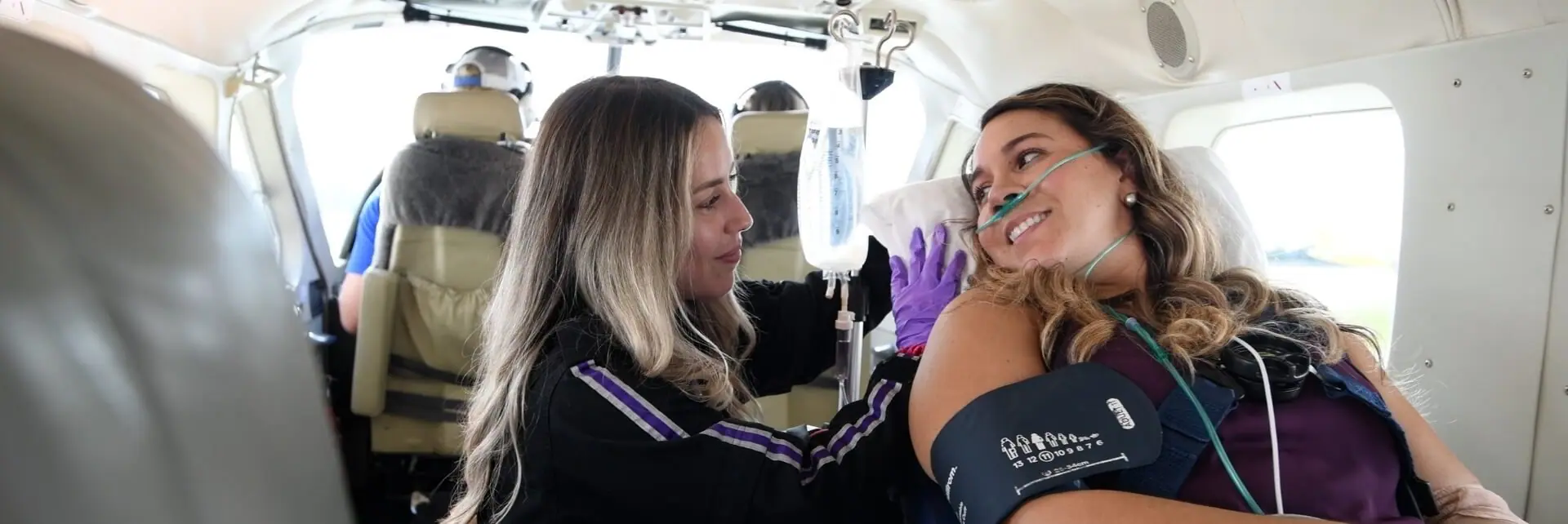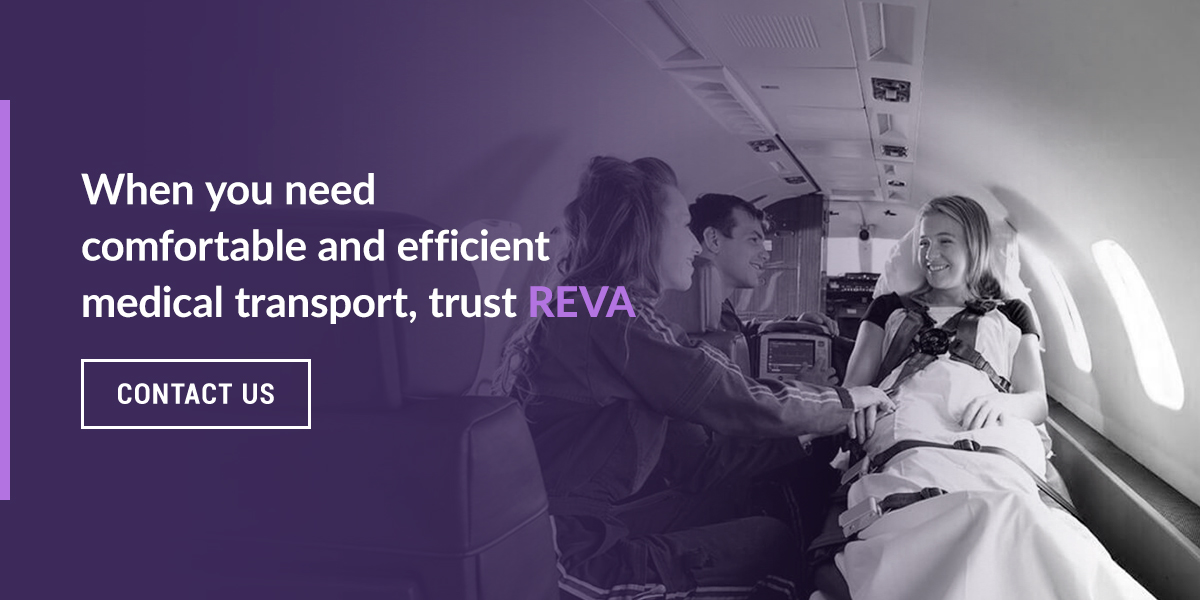Whether you’ve developed pneumonia while traveling abroad and want to return home or need to go to a far-away hospital for further pneumonia treatment, you need a way to get to your destination as safely and efficiently as possible. Flying is one of the fastest ways to travel long distances, but it can pose risks to those with this infection.
Learn what pneumonia is, what happens if you fly with pneumonia and how to mitigate the risks so that you can arrive at your destination safely and comfortably.
What Is Pneumonia?
Pneumonia is an infection that results in inflammation in the tissue of one or both of the affected individual’s lungs. This inflammation prevents the tissue from absorbing as much oxygen as usual, which decreases oxygen saturation in the blood. A patient’s lungs may fill with fluid or pus, causing coughs that produce phlegm or pus. Other symptoms include:
- Fever with sweating, shaking or chills
- Chest pain when breathing or coughing
- Shortness of breath
- Nausea
- Vomiting
- Diarrhea
- Loss of appetite
- Fatigue
There are many causes of pneumonia, such as:
- Bacteria: Bacterial pneumonia is one of the most common types. It can occur on its own or develop after a cold or the flu, usually affecting just one part of a lung. Pneumonia caused by bacteria can be treated with antibiotics. Individuals are contagious until about 48 hours after they’ve started antibiotics and once their fever has gone away.
- Viruses: Many viruses that infect the upper respiratory tract can cause pneumonia. This type of pneumonia is contagious, but the contagion period typically fades once the symptoms start to go away. Most cases of viral pneumonia are not serious and last a shorter time than bacterial pneumonia. Some types of viral pneumonia can have severe effects, though, causing low oxygen levels and respiratory failure.
- Aspiration: Another cause for pneumonia is aspiration, which occurs when food, drink, vomit or salvia are inhaled and enter the lungs. This type of pneumonia is common when an individual is experiencing a problem with their gag reflex.
- Fungi: Fungal pneumonia develops in individuals who are exposed to large amounts of certain types of fungi in contaminated soil. It is most common in those with chronic health problems or weakened immune systems. This form of pneumonia is not contagious and can be treated with antifungal medication.
Pneumonia is often mild, with symptoms fading after two to three weeks with medicine, rest and care at home. However, this infection can also have more severe side effects that pose a risk to an individual’s life, requiring medical attention and care at a hospital.
Who Does Pneumonia Affect?
Pneumonia can affect anyone, but it is particularly dangerous for three main groups of people:
- Children: Infants and young children are more susceptible to pneumonia because their immune systems are still developing. Newborns and infants may not show signs of pneumonia when they have it, but some may have symptoms such as a fever, cough, or difficulty breathing and eating.
- Older adults: People over 65 are at a higher risk of pneumonia than younger adults. In addition to the most common symptoms, older adults may experience lower body temperatures and changes in mental awareness.
- Individuals with weakened immune systems: Those with health issues, an organ transplant or exposure to chemotherapy are more likely to have pneumonia due to their body’s inability to fight off the infection. These individuals may have lower body temperatures as a symptom of the pneumonia.
While these three groups of people are at a higher risk of contracting pneumonia, the infection can affect anyone. A few risk factors include:
- Hospitalization: Spending time in a hospital, especially when on a machine that helps you breathe, increases the chances of getting pneumonia.
- Chronic diseases: Asthma, chronic obstructive pulmonary disease (COPD), heart disease and other chronic issues may increase the likelihood of pneumonia.
- Smoking: The body’s ability to defend against pneumonia-causing bacteria and viruses is damaged by smoking.
Is It Dangerous to Fly With Pneumonia?
It can be dangerous to fly with pneumonia on a commercial flight because of the air pressure changes that occur. Even though passenger cabins are pressurized, they still decrease in air pressure as the plane reaches higher altitudes. Most people are unaffected by the changes, but those with pneumonia may encounter uncomfortable and even dangerous side effects.
Decreased air pressure leaves more room for fluid to expand, putting pressure on the lungs and the brain. It also makes it harder for the lungs and heart to absorb oxygen. Since pneumonia already inhibits the body’s ability to receive the oxygen it needs, the body may fall to critical oxygen levels during a flight. Low oxygen levels can prevent various organs from working properly and lead to life-threatening situations.
It is also not safe to fly with pneumonia if you have a contagious type. Bacterial and viral pneumonia can spread through respiratory droplets in the air, such as when an infected individual coughs or sneezes. Traveling on a commercial flight when your pneumonia is contagious can put those around you at risk of contracting the infection, especially if they have an underlying medical condition that makes flying unsafe.
Pneumonia and Flying Restrictions
Commercial airlines have many restrictions when it comes to items allowed on aircraft. Airliners usually have regulations about oxygen, liquid medication, syringes, and other forms of medicine and medical equipment. If you plan to fly commercially, you’ll need to check with your specific airliner to determine what restrictions are in place and if you’ll need a doctor’s note to bring any medical supplies.
It is always best to visit a doctor before planning a flight. During your visit, your doctor may have you take a fit-to-fly test that checks your oxygen intake and levels. If you have low oxygen levels, your doctor will either recommend bringing oxygen on your flight or classify you as unfit to fly. If you are unfit to fly, airline companies will not let you board a flight.
You should not fly with pneumonia if your case is contagious. If you have mild bacterial or viral pneumonia, wait until your symptoms have subsided and your doctor gives you permission to travel again.
What’s Your Best Option When Traveling With Pneumonia?
You can fly when you have pneumonia if you travel under the right conditions. Your options include flying alone or with a medical escort on a commercial flight or taking an air ambulance.
Commercial Flights
While flying alone on a commercial airline is a possibility for mild, noncontagious cases of pneumonia, it is not recommended. Some individuals can travel this way without aggravating their condition, but there are several risks to consider, such as the effects of air pressure changes and a lack of medical personnel and equipment. Airliners also have many restrictions about the type of oxygen and medications you can bring on a flight, making traveling more complicated and stressful.
Medical Escorts
Individuals with mild and noncontagious pneumonia or those in recovery with few remaining symptoms might find comfort and peace of mind when traveling with a medical escort. These professionals will accompany you throughout your journey to ensure your safety and health. They will be available to respond in case of an emergency and provide the services you need. Medical escorts can also reassure you throughout the flight to help you feel more confident as you travel to your destination.
Air Ambulances
An air ambulance is the safest way to travel when you have pneumonia, especially for serious cases that need treatment at a distant medical facility. These aircraft have cabin pressure controls so that they remain at a steady level throughout the flight, helping create a safe environment when you have pneumonia. Medical personnel and equipment will also be available to attend to you mid-air. Air ambulances will ensure you have the oxygen you need to remain safe, comfortable and healthy throughout your flight.
Will Your Insurance Cover Flying With Pneumonia?
If you are traveling abroad and discover you have pneumonia, you may want to fly home as soon as possible. Or, if you are at home and discover you have a serious case of pneumonia, you may need to travel long distances to a medical facility that can care for your needs. Some insurance policies may help cover transport if it is:
- Medically necessary: Some insurers may cover a flight if you can only receive life-saving care at a distant location. If an insurance policy covers medical transport, it is most likely for this type of flight.
- Medically reasonable: A few insurance companies cover medically reasonable flights, where you could receive care locally but traveling further would bring you better health outcomes. This type of coverage is less common, so reading through your policy is important to determine what is covered.
If your insurance does not cover any medical transportation, you can apply for travel medical insurance. These policies have different types of coverage, so you’ll want to read your policy thoroughly to ensure your medical flight is included.
Let REVA Manage Your Medical Flight
You can travel with pneumonia in security and comfort when you work with REVA. Our priority is to enhance the lives of each of our clients by transporting them to their destinations with efficiency and safety in mind. When you need to fly home or to a treatment center to care for your pneumonia, let REVA handle the details.
Trust Our Process
At REVA, we follow a simple process to ensure you get the fast, safe and efficient medical flights you need. We coordinate every aspect of your travel experience, from the medical teams to the clinical and travel documentation. Our staff will arrange every detail with precision and compassion to create a comfortable and convenient flying experience.
Receive Insurance Guidance
Our insurance specialists will help you find coverage and determine the best financial solutions so that you can receive the transportation and care you deserve. We’ll answer your insurance questions and guide you through the reimbursement process. Our team will manage your insurance procedures, preparing documents and appealing decisions to ensure you find the best coverage.
Rely on Highly Trained Professionals
We hold our medical, flight and ground crews to the highest safety and professional standards, so you can enjoy a seamless bedside-to-bedside experience. Our medical team consists of highly qualified specialists in emergency care who can provide the expert medical services you need mid-air. Our flight crews have extensive aviation experience and training, so you can trust us to fly you to your destination as safely and efficiently as possible.
Fly in Dedicated Aircraft
REVA has a fleet of fixed-wing dedicated air ambulances configured with the latest critical-care equipment to assist with emergency and non-emergency flights. Also, our strategic partnerships allow us to meet your needs wherever you may be in the world. Whether you need to travel domestically or fly internationally, we have you covered.
Enjoy High Safety Standards
We put safety first at REVA, so our clients and employees can have peace of mind throughout the transport process. Our teams undergo rigorous training constantly to ensure we are current on the latest safety procedures and guidelines. With highly organized safety programs, detailed policies and constant risk control assessments, we can provide smooth and efficient transport.
Request a Quote Today
When you need comfortable and efficient medical transport, trust REVA. Our team is available 24/7 to help you find travel solutions that ensure your health and well-being. Contact us today to learn more about our worldwide capabilities and request a quote to see how we can help with your unique situation.


